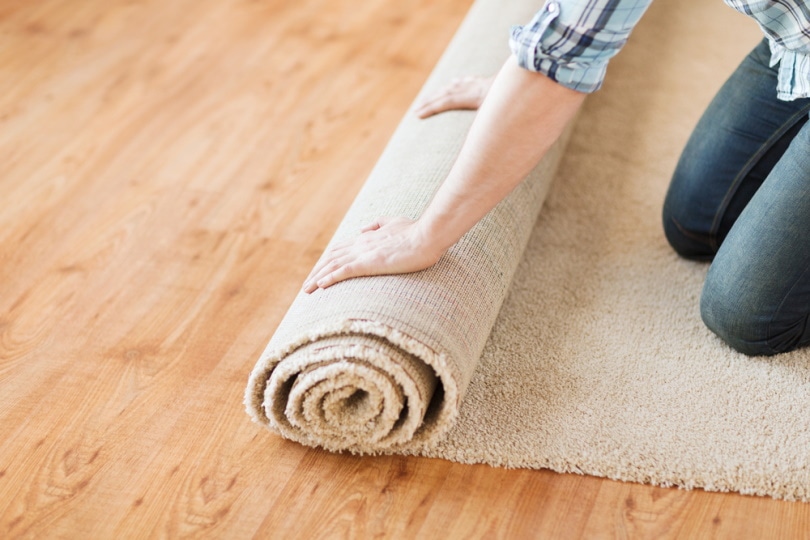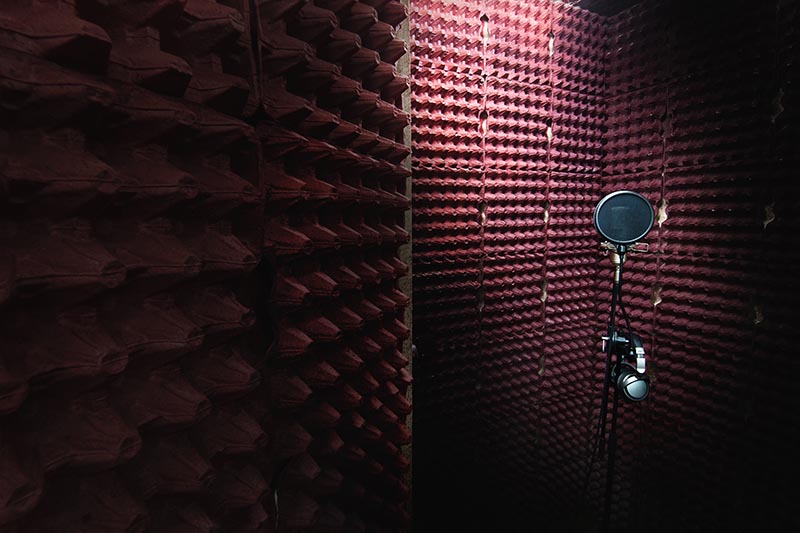How to Soundproof a Garage: 5 Tips & Tricks
-
Pete Ortiz
- Last updated:

Although they were designed for parking and working on cars, most people use garages to carry out their personal tasks. Some want to practice their band music or guitars there, while others prefer doing their DIY carpentry chores there. But garage tasks often share a common downside: they are noisy.
Perhaps you are considering how to constrain the noise from disturbing the neighbors or attracting unnecessary attention. In that case, the best option is to soundproof your garage. Although the lightweight roofs, windows, and doors can make it impossible to soundproof a garage effectively, the process significantly helps reduce the amount of noise breaking out.
This guide provides tips and tricks of soundproofing a garage while emphasizing how to deal with the doors and windows because they are the weakest points.¹
The 5 Tips & Tricks on How Soundproof Your Garage
1. Soundproof Your Garage Door
According to Soundproof Central, there are several approaches to soundproofing a garage door, but they all depend on the amount of space, the type of noise produced, and your budget plans.2 And since the door is the part that lets out the most noise, you need to be thorough when soundproofing them.
The following tips will help you do it well:
Seal All the Gaps
The door leaks out two types of noises; impact and airborne noise. The airborne noise results from TV sounds, radio, voices from the room next door, etc., while impact noise is the result of vibrations from musical instruments, body works, carpentry, and other activities inside the garage.
Cover the bottom, sides, and top of the door completely using dedicated seal kits such as a compressible rubber seal. Sealing all gaps is key for limiting the let-out of airborne sound leakages – but they aren’t 100% effective. That’s where our second trick comes in.
Install Sound Insulation
Sheets or acoustic blankets are excellent material for soundproofing movable parts; that’s why you should use them on your garage door. The sound-absorbing properties of fiberglass, which is the material used to make acoustic blankets, play a great role in preventing noise from going through the door.
But because it’s too large and requires extra space and effort to resize and cut, most homeowners prefer a cheaper and lighter option—that’s where moving blankets come into play. They are larger than regular blankets but can absorb noise more effectively.
Both acoustic and moving blankets are good for soundproofing garage doors. The best thing about them is that they allow your door to keep functioning. So, select one and insulate the whole door while ensuring you leave no space in the edges.
It’s important to note that acousting and moving blankets and sheets have a sound absorption level up to 50%. If you desire a more effective option, especially for band practice or home theaters, you’ll have to go for door insulation panels. They may be too expensive but the results won’t disappoint you.
While noise is determined by Sound Transmission Class (STC), door insulation panels help increase STC to reduce outside noises by up to 6dB. They also provide good thermal value, meaning they can minimize heat gain and heat loss to make your home energy-efficient.
2. Soundproof Your Garage Windows
Window views are not essential when you are practicing band music or carpentry. So, depending on how soundproof you want to make your garage, there are several options to decide from:
Brick Up the Windows
It’s common knowledge that walls are better soundproofers than glass. For this reason, you can consider filling the window space with more bricks instead of employing alternative soundproofing methods. Besides saving on costs, bricking windows serves as an effective solution for controlling noise in your garage.
Acoustic Plugs
Our second alternative is by adding an air-seal known as acoustic plug for windows. It resembles an extra window but has sound-absorbing properties that work well if bricking isn’t an option. To use it, you must determine the size of your window first, then cut the acoustic plug into fitting dimensions and pin to the inside of your garage window.
Window acoustic plugs are good for trapping noise and preventing it from leaking outside. They are also easy to install and remove, making it ideal for regular band practice members. However, if you desire to add more ambience and effectiveness to your garage sound, there’s still another option- soundproof curtains.
Soundproof Curtains
Soundproof curtains and blankets not only absorb noise but also make the experience more comfortable by creating a more ambient space. Their materials are layered in a way that captures sound in its threads, therefore they can’t easily let noise escape.
If you plan to carry out drumming sessions in your garage, soundproof curtains and blankets will be perfect because they also help absorb the sound reflected off the roof and walls.
3. Soundproof the Garage Walls
Add Soundproof Insulation
As silly as it may sound, garage walls do let out a substantive amount of noise. That’s why most amateur music studios cover their walls with cheap solutions like soundproofing curtains to create a more suitable environment for recording. If they aren’t effective yet, the studio managers often add more soundproof material to overlap the threads and capture more sound.
In advanced studios, you’ll notice that their walls are fitted with acoustic blankets and soundproof tiles. They are more effective but also expensive and quite difficult to set up.
In other executive settings, special soundproof panels for walls are used to cut out incoming and outgoing noise. They are effective by up to 75%, costing more in consequence. But to minimize noise the most, our second option would be the most ideal.
Construct a “Room within a Room”
When we talk about “Room within a Room” in soundproofing, we literally mean constructing another physical wall inside the garage to create extra sound barriers. This technique, also known as decoupling, is mostly used by musicians because it’s more effective for absorbing noise than wall soundproof curtains. However, it’s the downside of constructing a new drywall is the excess space it requires and the cost constraints.
If constructing drywall is not an option, you can still create a “Room inside a Room” using fiberglass and it will work just fine. Some experts may also prefer building staggered studs as a perfect compromise for saving space needed by additional drywalls – just figure out the option that works best for you.3
4. Soundproof the Floor

Remember some sounds will bounce from the floor as you work in the garage. To trap them, you can spread an old carpet or any other soft material across the floor.
Besides capturing the noises, the carpet will let you practice music barefoot like some musicians do. You can then feel the vibrations on your feet or tap along as you like without producing distractive noises. If you don’t have an old carpet, consider purchasing and installing acoustic flooring.
5. Soundproof the Ceiling
Like other parts of the garage, you must soundproof the ceiling as well. Some of the best materials for protecting sound from leaking through garage roofs include foam panels, acoustic blankets, and soundproofing tiles.
You must note, however, that soundproofing a ceiling may demand erecting new joists at a relatively lower level than the existing ones. Once you are sure they are parallel, go ahead and fix the soundproof material to cover all the roof and you are good to go.
The 5 Tips for Soundproofing Your Garage
Several factors can affect how you’ll carry out your soundproofing process, including your intended use, size, and features of the garage, etc. Nonetheless, the following tips will come in handy if you intend to do a good job:
1. Build a Room Inside a Room
If the garage is where you carry out your noisiest tasks, decoupling will help you control the resulting noise best. For instance, in drumming and music, the technique absorbs low frequencies from drums and bass instruments while leaking the least noise possible.
2. Use Different Techniques
The more soundproof barriers you can put between your working space and the outside space, the better you can block noise and maintain a desirable garage. That’s why it’s a good idea to combine multiple soundproofing techniques applicable to garage doors, windows, floors, walls, and ceilings.

3. Use Resilient Channels
While we didn’t discuss them in our previous section, resilient channels help maximize the soundproofing capabilities of your garage. These are metal beams that keep shock from vibrating through walls.
4. Place Rubber Beneath Machines
If you intend to use your garage as a workshop, consider adding a layer of rubber between the floor carpet and your working machines to help absorb vibrations.
5. Block the Machine Cabinets With Dampening Materials
Our last tip is to apply sound-deadening materials on the machine cabinets to help reduce the high frequency of your tools.4
Conclusion
You can keep doing what you love despite the complaints made by neighbors and family members. But before they file for a complaint, you must install soundproof materials to absorb the noise.
Although combining the several techniques highlighted in this guide can cost quite a fortune, you can rest assured that the soundproof system will be effective.
Featured Image Credit: Damir Kopezhanov, Unsplash
Contents



